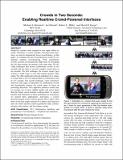Crowds in two seconds: Enabling realtime crowd-powered interfaces
Author(s)
Bernstein, Michael S.; Brandt, Joel; Miller, Robert C.; Karger, David R.
DownloadKarger_Crowds in two seconds.pdf (5.948Mb)
OPEN_ACCESS_POLICY
Open Access Policy
Creative Commons Attribution-Noncommercial-Share Alike
Terms of use
Metadata
Show full item recordAbstract
Interactive systems must respond to user input within seconds. Therefore, to create realtime crowd-powered interfaces, we need to dramatically lower crowd latency. In this paper, we introduce the use of synchronous crowds for on-demand, realtime crowdsourcing. With synchronous crowds, systems can dynamically adapt tasks by leveraging the fact that workers are present at the same time. We develop techniques that recruit synchronous crowds in two seconds and use them to execute complex search tasks in ten seconds. The first technique, the retainer model, pays workers a small wage to wait and respond quickly when asked. We offer empirically derived guidelines for a retainer system that is low-cost and produces on-demand crowds in two seconds. Our second technique, rapid refinement, observes early signs of agreement in synchronous crowds and dynamically narrows the search space to focus on promising directions. This approach produces results that, on average, are of more reliable quality and arrive faster than the fastest crowd member working alone. To explore benefits and limitations of these techniques for interaction, we present three applications: Adrenaline, a crowd-powered camera where workers quickly filter a short video down to the best single moment for a photo; and Puppeteer and A|B, which examine creative generation tasks, communication with workers, and low-latency voting.
Date issued
2011-10Department
Massachusetts Institute of Technology. Computer Science and Artificial Intelligence Laboratory; Massachusetts Institute of Technology. Department of Electrical Engineering and Computer ScienceJournal
Proceedings of the 24th Annual ACM Symposium on User Interface Software and Technology (UIST '11)
Publisher
Association for Computing Machinery (ACM)
Citation
Michael S. Bernstein, Joel Brandt, Robert C. Miller, and David R. Karger. 2011. Crowds in two seconds: enabling realtime crowd-powered interfaces. In Proceedings of the 24th annual ACM symposium on User interface software and technology (UIST '11). ACM, New York, NY, USA, 33-42.
Version: Author's final manuscript
ISBN
978-1-4503-0716-1